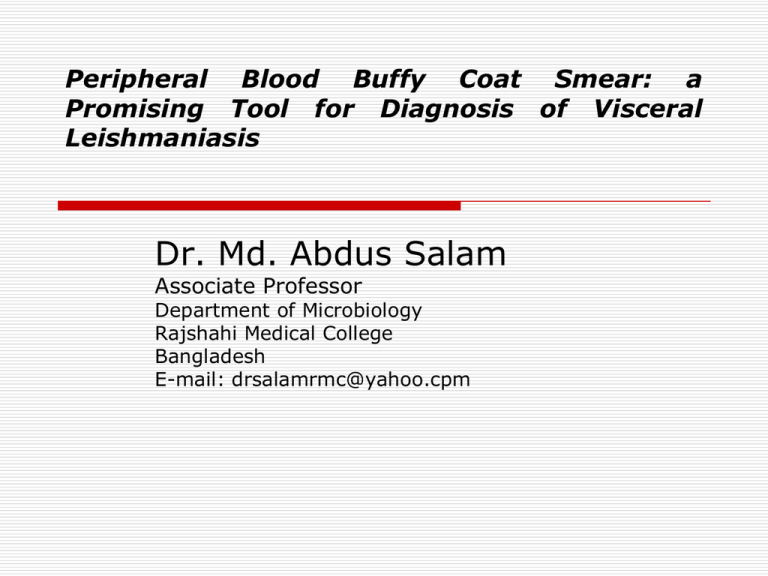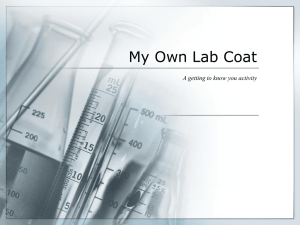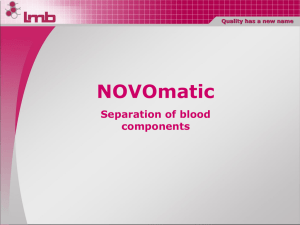Peripheral Blood Buffy Coat Smear: a Promising Tool for Diagnosis
advertisement

Peripheral Blood Buffy Coat Smear: a Promising Tool for Diagnosis of Visceral Leishmaniasis Dr. Md. Abdus Salam Associate Professor Department of Microbiology Rajshahi Medical College Bangladesh E-mail: drsalamrmc@yahoo.cpm BACKGROUND Visceral Leishmaniasis (VL), or Indian kala-azar, is a vector borne parasitic disease caused by an obligate intracellular hemoflagellate of the genus Leishmania (Leishman, 1903). It causes prolonged fever, anemia, hepato-splenomegaly, and weight loss (Boelaert et al. 2007) VL is fatal if it is not adequately treated. The current prevalence is estimated to be 45,000 cases, with more than 40.6 million people at risk of developing the disease in Bangladesh. Of 64 districts, at least 34 districts, including 105 upazilas (subdistricts), have been reportedly affected by kala-azar (Rahman et al. 2008) BACKGROUND (Contd.) The development of diagnostic tests for improved case management of VL has been rated as one of the most needed among the infectious diseases prevalent in the developing world (Mabey et al. 2004). Although the need for accurate VL diagnostics is obvious, innovation in this field has been slow. Currently, diagnostic options for VL include parasitological, serological, and molecular methods, (Sundar and Rai, 2002) and there is always a search for new diagnostic tool particularly suitable for field use, with high sensitivity and minimal invasiveness. BACKGROUND (Contd.) Isolation of the parasite in culture or microscopic demonstration in relevant tissues such as spleen or bone marrow remains the “gold standard” but these involve painful and sometimes fatal invasive procedures not feasible in the field. BACKGROUND (Contd.) Serodiagnosis using recombinant K39 antigen (rK39) is an attractive choice for kala-azar in India, Bangladesh and Nepal (Salam, 2008; Sundar et al. 2002) due to high sensitivity but its specificity is yet to be established. Further, its use to discriminate disease and asymptomatic infection is limited. PCR assay with buffy coat preparations to detect Leishmania DNA has been found to be 10 times more sensitive than that with whole blood preparation (Lachaud et al. 2001; Salam et al. 2010). However, for PCR, the need for sophisticated machines and trained personnel, as well as cost, are limiting factors. BACKGROUND (Contd.) Detection of Leishmania donovan bodies in peripheral blood buffy coat smears is an alternative procedure for the parasitological diagnosis of VL. In a few studies its sensitivity ranged from 50 to 99% (Monica, 1998). There are clear advantages of buffy coat over conventional smears for parasitological diagnosis in terms of minimal invasiveness, simplicity, cost-effectiveness and with its potential to be carried out for point-of-care VL case management. We report, this preliminary observation on the usefulness of buffy coat smear microscopy as a simple and effective method for parasitological diagnosis of VL in Bangladeshi patients. MATERIALS AND METHODS Ethical considerations: Ethical issues relating to this research protocol were reviewed by the Institutional Review Board of Rajshahi Medical College, Bangladesh, which gave approval. Informed written consent was obtained from each patient or from the legal guardian before splenic aspiration and venipuncture for the collection of blood samples. MATERIALS AND METHODS (Contd.) Patients: The subjects were 112 patients with VL as defined by the Bangladesh national kala-azar elimination guideline (Hossain, 2008), admitted in the Rajshahi Medical College Hospital (RMCH), Bangladesh during June 2009 to June 2010. One of the 112 cases was diagnosed as congenital VL and had been reported earlier (Haque et al. 2010). Blood collection: With all aseptic precautions, 3.0 ml of blood from each patient was collected into a vacuette (K3 EDTA tube). MATERIALS AND METHODS (Contd.) Serological test: The rK39 immunochromatographic test was done by using the Kalazar Detect rapid test (InBios International, Seattle, WA) as per the manufacturer’s instructions. Splenic aspiration: After relevant laboratory evaluations and following standard techniques as described by Bryceson (Bryceson, 1987), splenic aspiration was possible to be carried out for 66 patients by an experienced physician. Two goodquality smears were prepared at bedside for microscopic examination. MATERIALS AND METHODS (Contd.) Buffy coat preparation: Buffy coat was separated following the principle of concentration gradient separation by using Histopaque solution (Histopaque-1119; Sigma-Aldrich). Three milliliters of collected blood was layered onto 3 ml of the Histopaque-1119 solution in a sterile 15-ml centrifuge tube. The tube was capped and then centrifuged in a tabletop centrifuge at 4,000g for 10 min at ambient temperature. A diffuse gray band of leukocytes (buffy coat) in between the Histopaque solution and plasma above the erythrocyte pellet was aseptically removed with a pipette and transferred to a sterile 1.5 ml microcentrifuge tube to be utilized for smear preparation and as a sample for LnPCR. Concentration gradient separation of Buffy coat using Histopaque solution Plasma Buffy coat Histopaque solution Red blood cells MATERIALS AND METHODS (Contd.) DNA extraction: Buffy coat DNA was extracted for PCR using the QIAamp DNA Blood Mini Kit (Qiagen, Hilden, Germany) according to the manufacturer’s instructions. Ln-PCR: We used a previously reported Ln-PCR protocol with primers targeting the parasite’s small-subunit rRNA region (Curz et al. 2002). An advantage of this Ln-PCR is its high sensitivity and specificity due to the use of a second set of Leishmania-specific primers designed to an internal sequence of the first PCR product. PRIMERS FOR Ln-PCR Primers Oligonucleotide sequence (5’-3’) R221 (1st set) GGTTCCTTTCCTGATTTACG 0.3 µmol/L R332 (1st set) GGCCGGTAAAGGCCGAATAG 0.3 µmol/L R223 (2nd set) TCCCATCGCAACCTCGGTT 0.15µmol/L R333 (2nd set) WUGCGGGCGCGGTGCTG 0.10 µmol/L Primer concentration Ln-PCR Condition PCR components Volume (µL) Deionized water (H2O) 20.00 Forward primer, R221 0.50 Reverse primer, R332 0.50 MgCl2 2.00 Template DNA 2.00 Ln-PCR Protocol Steps Temperature Time Cycle number Step 1 94°C 5 min 1x Step 2 94°C 60°C 72°C 30 sec 30 sec 30 sec 40x Step 3 72°C 5 min 1x Ln-PCR amplified DNA in Gel Buffy coat smear microscopy Identifying points: (i) Amastigotes are usually seen extracellularly. (ii) The hallmark of identification of structures as amastigotes is the typical conjugation of a nucleus and kinetoplast of unequal sizes covered by a complete or partially complete cytoplasmic rim, however, the typical morphology of amastigotes as demonstrated in splenic or bone marrow smears may not be well preserved. (iii) Platelets are the only structures that may be confused with amastigotes but platelets usually remain as a cluster, and they are smaller than amastigotes. (iv) The number of amastigotes is low in a buffy coat smear in comparison to tissue smears. (v) Therefore, careful and patient searching is always required for clear demonstration of amastigotes. Amastigote in buffy coat smear Splenic smear microscopy Splenic smears were stained with Leishman stain and read in a standard way under magnification of x 1,000 for the presence of L. donovani amastigotes. The presence of L. donovani bodies was graded on a scale from 1+ to 6+. If the number of amastigotes counted per field was 100, 10 to 100, or 1 to 10, the grade was 6, 5, and 4, respectively. Similarly, the presence of 1 to 10 amastigotes in 10, 100, or 1,000 fields was graded as 3, 2, and 1, respectively (Chulay and Bryceson, 1983). Data analysis Descriptive statistical analysis, the chi-square test, the McNemar paired test, and analysis of variance (ANOVA) were used for data analysis, using SPSS 11.5 and R software. RESULTS Study population characteristics: Of 112 VL patients, 75 (67%) were male and 37 (33%) were female. The median age was 276 months (quartiles, 120 months and 384 months). All patients had splenomegaly ranging from just palpable to 12 cm from the costal margin along midclavicular line. All had positive rK39 tests and underwent buffy coat smear microscopy for L. donovani bodies and buffy coat Ln-PCR analysis for Leishmania DNA. Sixty six of 112 VL patients consented to spleen aspiration diagnosis. RESULTS (Contd.) Patients were treated with sodium antimony gluconate (SAG) at a dose of 10 to 20 mg/kg of body weight, with a maximum dose not exceeding 10 ml (800 mg), given intravenously (i.v.) daily without any interruption. All patients were discharged from hospital after 30 days of treatment with clinical improvements. RESULTS (Contd.) Laboratory results: Ninety-two percent (103/112), 95.5% (107/112), and 100% (66/66) of VL patients were positive by buffy coat microscopy, buffy coat PCR, and spleen smear microscopy, respectively. The mean ages ± standard errors (SE) of patients with and without positive buffy coat microscopy test results were 243 ± 72 and 276 ± 16, respectively (P 0.58). Ninety percent (68/75) of male patients and 94.6% (35/37) of female patients were positive by buffy coat microscopy (P 0.47). However, buffy coat Ln-PCR positivity was more common among female patients (93% [70/75] versus 100% [37/37]; P 0.16). RESULTS (Contd.) Leishmania amastigotes were found by buffy coat microscopy in 93.5% (100/107) of those positive by buffy coat Ln-PCR and in 92.4% (61/66) of those positive for Leishmania amastigotes by spleen smear microscopy. Compared to spleen smear microscopy, the positivity rates of buffy coat Ln-PCR and buffy coat microscopy was comparable (66/66 for PCR versus 61/66; P 0.06 by the McNemar paired test). Association of buffy coat smear positivity with spleen parasite burden Parasite load Spleen smear Buffy coat smear N (%) N (%) 1+ 2+ 3+ 4+ 5+ 12 (18.18) 26 (39.39) 16 (24.24) 7 (10.61) 5 (07.58) 8 (66.67) 25 (96.15) 16 (100) 7 (100) 5 (100) DISCUSSION The most important finding of the study is that buffy coat smear microscopy correlated excellently with clinical diagnosis of VL as per the national kala-azar elimination guideline, buffy coat Ln-PCR for Leishmania donovani DNA, and confirmatory diagnosis of VL by spleen aspirate smear. Another important finding is that the recommendation for diagnosis and treatment of VL based on clinical criteria in the national kalaazar elimination program is correct, since clinical diagnosis in 66 VL patients was justified by spleen aspirate smear, which is the gold standard for diagnosis of VL. DISCUSSION (Contd.) Currently most VL patients are clinically diagnosed and treated in the subdistrict hospitals of Bangladesh, where facilities for the use of confirmatory diagnostic tools are not available. Buffy coat smear can be used as a confirmatory diagnostic tool in these health facilities. However, its sensitivity and specificity have to be validated by further study following the standards for field evaluation of VL diagnostics for its recommendation as a confirmatory test (Boelaert et al. 2007). DISCUSSION (Contd.) In conclusion, we found buffy coat smear to be a promising confirmatory diagnostic tool for VL which can be used for point-of-care diagnosis in resource-limited health facilities. However, a well-designed study following the recommended standards for evaluation of VL diagnostic tools is highly desired for recommendation of buffy coat smear as a confirmatory diagnostic tool for VL. Published Article Salam MA, et al. Peripheral Blood Buffy Coat Smear: a Promising Tool for Diagnosis of Visceral Leishmaniasis. J. Clin. Microbiol. March 2012 50:837-840; published ahead of print 28 December 2011 , doi:10.1128/JCM.05067-11 THANK YOU






